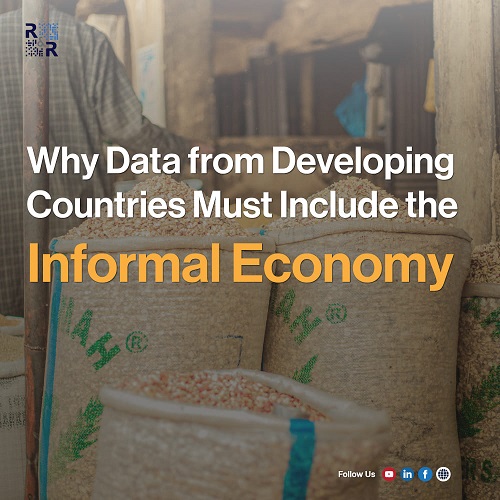In development research, we often analyze statistical models, national accounts, surveys, and international data repositories. Yet one critical factor frequently slips through the cracks: the informal economy — the unregistered, unregulated, and largely unrecorded portion of production and employment.
Failing to recognize this hidden sector distorts our understanding of how economies function, especially in the Global South. In many developing countries:
- The informal economy provides work for over 60% of the employed population
- It contributes about 35% of GDP on average in low- and middle-income countries
- In emerging-market and developing economies, informal work may exceed 70% of employment and nearly one-third of GDP
Thus, when formal datasets omit microbusinesses, household production, day labor, informal vendors, or gig workers, what remains is only a partial and distorted image of economic reality.
The Hidden Risks of Ignoring Informality
Below is a summary of how omission of the informal sector degrades research quality.
| Problem | Consequence | Research Impact |
| GDP undercount | National accounts understate total output | Underestimates economic size and growth potential |
| Biased poverty & inequality measures | Poor may dominate informal sectors | Inequality metrics skewed toward formal-sector patterns |
| Flawed impact evaluation | Many interventions target formal firms | Underestimates spillovers or indirect effects |
| Weak policy design | Policies assume formal channels | Ignorance of informal responses & coping strategies |
| Revenue & taxation gaps | Informal sector escapes fiscal net | Underestimates revenue potential and tax base |
For example, many researchers assume that formal labor surveys represent the entire workforce. But in reality, informal labor is disproportionately composed of:
- Self-employed street vendors
- Home-based enterprises
- Unregistered service workers
- Gig and platform labor
In India, up to 92% of non-agricultural employment is estimated to be informal.
In South Asia generally, more than 80% of workers are informally employed.
How to Capture the Informal Economy: Methods & Approaches
To bridge this data gap, researchers must adopt a triangulated approach. Below are strategies we recommend at Research & Report Consulting:
- Multiple-source datasets: Combine formal surveys (e.g., labor force surveys) with micro-enterprise censuses, household modules, or special modules targeting informal activity.
- Ethnographic & qualitative fieldwork: Interview informal workers, observe business operations, trace household enterprises to capture hidden practices and coping mechanisms.
- Proxy and remote-sensing data: Use satellite imagery (e.g., night lights, land use patterns) or mobile phone transaction data as proxies for unobserved economic activity.
- Model-based estimation: Leverage econometric models such as MIMIC (Multiple Indicators Multiple Causes), dynamic general equilibrium, or latent variable approaches implemented in the World Bank’s Informal Economy Database.
- Temporal & cross-sectional adjustments: Introduce shadow correction factors when comparing across time or countries to account for changes in informality.
Best Practices & Pitfalls to Watch
- Avoid treating informality as a residual: Don’t simply define it as “everything not captured” — that assumes errors rather than real activity.
- Disaggregate by sector and region: Informality in agriculture differs from urban service informality.
- Adjust for heterogeneity: Informal firms vary in scale, profitability, and linkages to formal markets.
- Be cautious with proxies: Night lights may miss small-scale home production.
- Document assumptions clearly: Transparent methodology helps peer scrutiny and reproducibility.
Conclusion
To understand developing economies, we must bring hidden economies into the light. Integrating informal sectors into research ensures richer insights, more just policy, and stronger development outcomes.
Question for you: In your region or country, what informal activities do you believe are most critical but under-counted? Please share examples in the comments below.
Let’s spark deeper understanding — one hidden economy at a time.
References
- “Five Things to Know about the Informal Economy” — IMF
- “Long Shadow of Informality: Challenges & Policies” — World Bank
- World Bank Informal Economy Database (1990–2020) — World Bank
- ILO statistics on informality (global & regional shares) — ILO
- “Analysing the Informal Economy: Data Challenges” — Ackrill et al. (2024)
Want research service from Research & Report experts? Please contact us.

